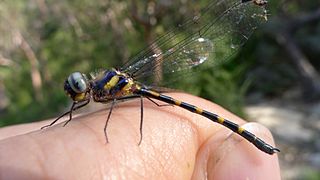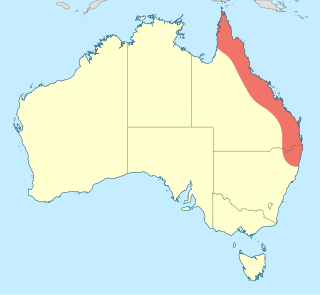
Coenagrionidae or are a family of damselflies, also known as pond damselfies, in the order Odonata and the suborder Zygoptera. The Zygoptera are the damselflies, which although less known than the dragonflies, are no less common. More than 1,300 species are in this family, making it the largest damselfly family. The family Coenagrionidae has six subfamilies: Agriocnemidinae, Argiinae, Coenagrioninae, Ischnurinae, Leptobasinae, and Pseudagrioninae.

The Lestidae are a rather small family of cosmopolitan, large-sized, slender damselflies, known commonly as the spreadwings or spread-winged damselflies.

The Platycnemididae are a family of damselflies. They are known commonly as white-legged damselflies. There are over 400 species native to the Old World. The family is divided into several subfamilies.

Austrocordulia is a genus of dragonfly in the superfamily Libelluloidea, endemic to northern and eastern Australia. Species of Austrocordulia are medium-sized, dark-coloured dragonflies, either brown or black with yellow markings.

Lathrocordulia is a genus of dragonfly in the superfamily Libelluloidea, endemic to Australia. Species of Lathrocordulia are medium-sized, bronze to black dragonflies without pale markings,

Archaeophya is a small genus of dragonflies assigned to the superfamily Libelluloidea. Species of Archaeophya are large dragonflies with metallic-coloured bodies, dark with yellow spots, and clear wings. They only occur in eastern Australia.

Platystictidae is a family of damselflies, commonly known as shadowdamsels. They look very similar to the threadtail damselfly family (Protoneuridae). They can mostly be found throughout Asia, Central America, and South America.

The Synlestidae are a family of damselflies commonly known as sylphs or malachites. They occur in South Africa, Australia, and South America.

The Lestoideidae are a family of damselflies occurring in South-east Asia, New Guinea and Australia. The family comprises two genera and nine species.

Coenagrionoidea is a superfamily of closed wing damselflies of the order Odonata found worldwide.

Diphlebiidae is no longer recognised as a biological family. It was the name given to a small family of damselflies, the azure damselflies, with species in two genera: Diphlebia and Philoganga. Diphlebia is found in Australia and Philoganga is found in Southeast Asia. They are large and thick-bodied damselflies. They rest with their wings spread out. The Diphlebiidae were also known as Philogangidae.

Aeshnoidea is a superfamily of dragonflies that contains two extant families, Aeshnidae and Austropetaliidae.

Libelluloidea is a superfamily of dragonflies.

Cordulephya is a genus of dragonflies assigned to the superfamily Libelluloidea, and endemic to eastern Australia. The species are small to tiny in size, coloured black, or purplish-black, with yellowish markings. Unusually for Anisoptera, these dragonflies rest with their wings folded above their body in a similar manner to many species of damselfly. They are commonly known as shutwings.
Austrocorduliidae was formerly considered a family of dragonflies occurring in South Africa and Australia. Recent taxonomic revisions have classified the species previously placed in Austrocorduliidae to now be within the superfamily Libelluloidea.

Micromidia is a genus of dragonflies in the superfamily Libelluloidea. They are small to medium-sized dragonflies, coloured black or metallic green with pale markings, and endemic to eastern Australia.

Austrophya is a genus of dragonflies in the superfamily Libelluloidea, endemic to north-eastern Australia.
Gomphomacromiidae was formerly considered a distinct family of dragonflies occurring in Chile and Australia. Recent taxonomic revisions have classified the species previously placed in Gomphomacromiidae to now be within the superfamily Libelluloidea.

Pseudocordulia is a small genus of dragonflies endemic to tropical northeastern Australia. They are medium-sized, bronze-black dragonflies with clear wings.

Calopterygoidea is a superfamily of damselflies in the order Odonata.


















